
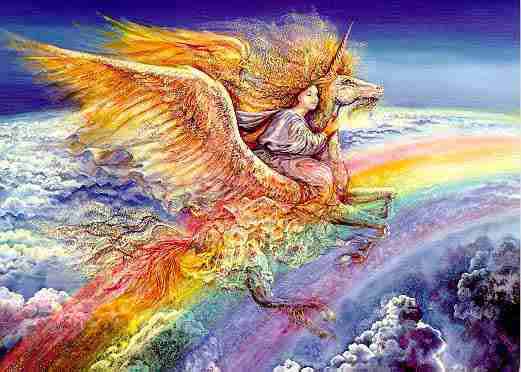 <>
<>

 <>
<>
The unicorn is a mythical creature usually depicted with the body of a horse, but with a single, usually spiral, horn growing out of its forehead, thus its name cornus Latin for 'horn'. The unicorn has been described since antiquity depicted in ancient seals of the Indus Valley Civilization and was mentioned by the ancient Greeks in accounts of natural history by various writers, including Ctesias, Strabo, Pliny the Younger, and Aelian. The Bible also describes an animal, the re'em, which some versions translate as unicorn.
In European folklore, the unicorn is often depicted as a white horse-like or goat-like animal with a long horn and cloven hooves (sometimes a goat's beard). In the Middle Ages and Renaissance, it was commonly described as an extremely wild woodland creature, a symbol of purity and grace, which could be captured only by a virgin. In the encyclopedias, its horn was said to have the power to render poisoned water potable and to heal sickness. In medieval and Renaissance times, the tusk of the narwhal was sometimes sold as unicorn horn. Read more
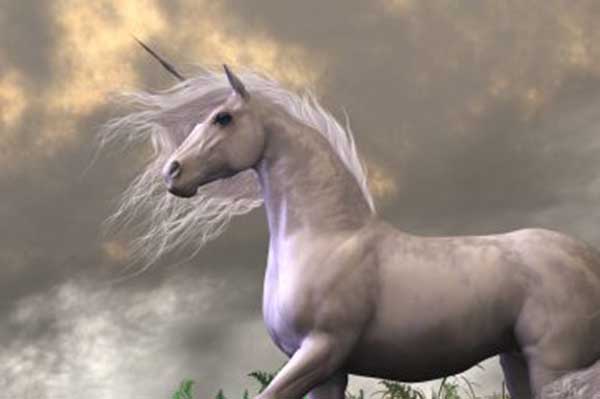
April 9 - Unicorn Day
Adam in the Garden of Eden at the Beginning of Time
Emperor Fu Hsi China 5,000 years ago
Emperor Huang Di Emperor's garden in China 2697 B.C
Emperor Yao China About 2,000 B.C
Confucius China 551-479 B.C
Ctesias India 4th century B.C
Alexander the Great Asia 3rd century B.C.
Julius Caesar Germany 1st century B.C.
Prester John Asia Mid- 1100s
Genghis Khan India Early 1200s
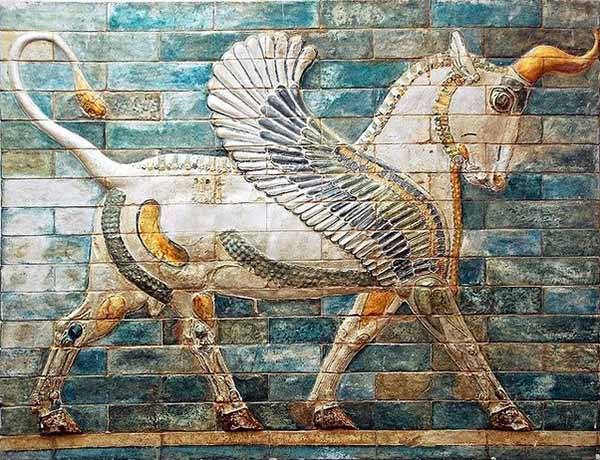
Winged aurochs, 510 BC, Palace of Darius in Susa, Susa, Iran (Louvre)
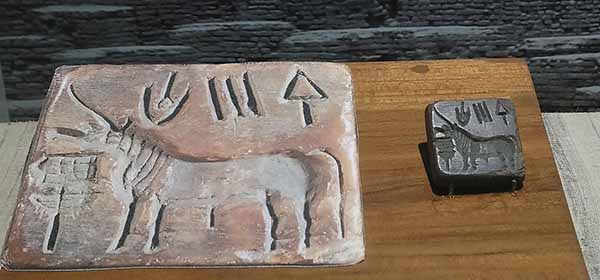
Unicorn seal of Indus Valley, Indian Museum
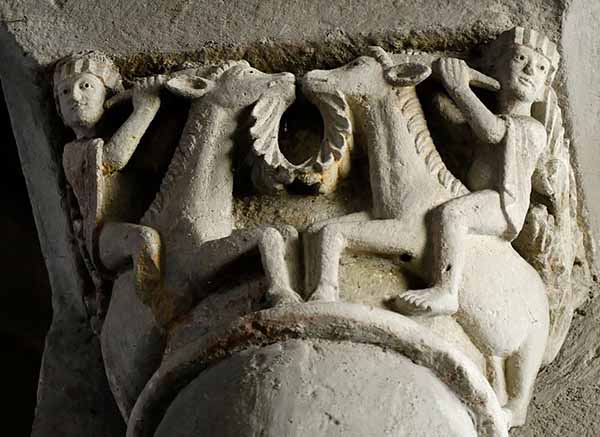
Youths riding goats (a Dionysiac motif in antiquity) on 12th-century capitals from
the abbey of Mozac in the Auvergne. The goats are indistinguishable from unicorns.
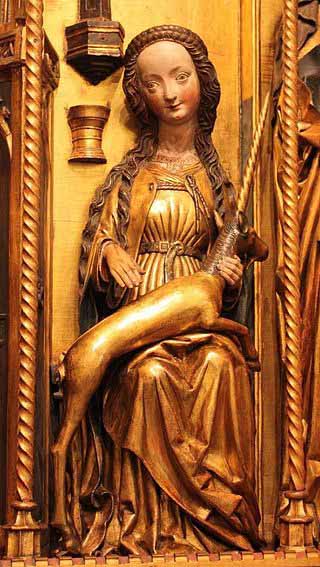
Virgin Mary holding the unicorn (c. 1480),
detail of the Annunciation with the Unicorn Polyptych,
National Museum, Warsaw
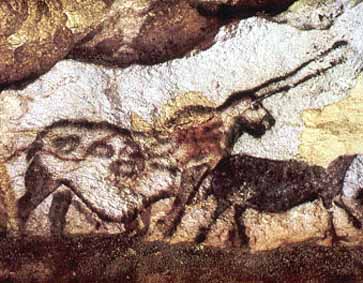
A prehistoric cave painting in Lascaux, France depicts an animal with two straight horns emerging from its forehead. The simplified profile perspective of the painting makes these two horns appear to be a single straight horn; since the species of the figure is otherwise unknown, it has received the name "the Unicorn". Richard Leakey suggests that it, like the Sorcerer found at Trois-Freres, is a therianthrope, a blend of animal and human; its head, in his interpretation, is that of a bearded man.
There have been unconfirmed reports of aboriginal paintings of unicorns at Namaqualand in southern Africa. A passage of Bruce Chatwin's travel journal In Patagonia (1977) relates Chatwin's meeting a South American scientist who believed that unicorns were among South America's extinct megafauna of the Late Pleistocene, and that they were hunted out of existence by man in the fifth or sixth millennium BC. He told Chatwin, who later sought them out, about two aboriginal cave paintings of "unicorns" at Lago Posadas (Cerro de los Indios).
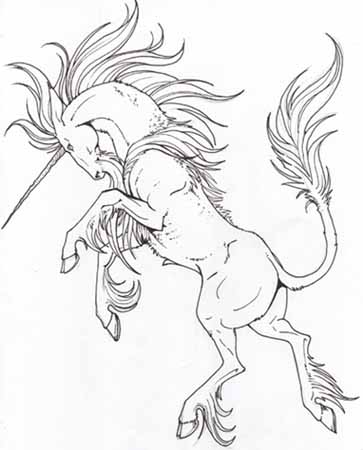
Though the popular image of the unicorn is that of a white horse differing only in the horn, the traditional unicorn has a billy-goat beard, a lion's tail, and cloven hooves, which distinguish him from a horse. In even the earliest references he is fierce yet good, selfless yet solitary, but always mysteriously beautiful.
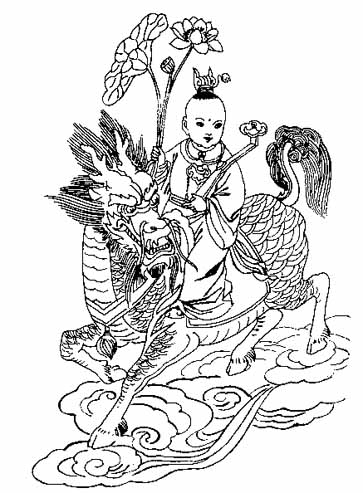
In China the qilin a mythology creature sometimes called "the Chinese unicorn". It is portrayed as a hybrid animal that is less unicorn than chimera, with the body of a deer, the head of a lion, green scales and a long forwardly-curved horn.
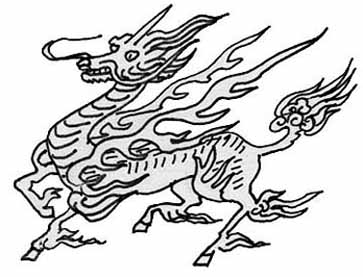
The Japanese "Kirin", though based on the Chinese animal, is usually portrayed as more closely resembling the Western unicorn than the Chinese qilin.
According to an interpretation of seals carved with an animal which resembles a bull (and which may in fact be a simplistic way of depicting bulls in profile), it has been claimed that the unicorn was a common symbol during the Indus Valley civilization, appearing on many seals. It may have symbolized a powerful social group.
Certain poetical passages of the biblical Old Testament refer to a strong and splendid horned animal called re'em. This word was translated "unicorn" or "rhinoceros" in many versions of the Bible, but many modern translations prefer "wild ox" (aurochs), which is the correct meaning of the Hebrew re'em.
The authorized version has nine references to the animal, among them: "God brought them out of Egypt; he hath as it were the strength of an unicorn." (Numbers 23: 22). Yet the biblical references appear to be due to a linguistic error made by Hebrew scholars in the 3rd century B.C. when they translated the Bible into Greek. They rendered the Hebrew re'em (meaning "aurochs," a wild, long-horned ox by then extinct in the Holy Land) as monoceros (meaning "single-horned"), which translates 'from the creek became unicorn'. As a result the Scriptures seemed to lend weight to the belief that the animal existed.
As a biblical animal the unicorn was interpreted allegorically in the early Christian church. One of the earliest such interpretations appears in the ancient Greek bestiary known as the Physiologus, which states that the unicorn is a strong, fierce animal that can be caught only if a virgin maiden is thrown before it. The unicorn leaps into the virgin's lap, and she suckles it and leads it to the king's palace. Medieval writers thus likened the unicorn to Christ, who raised up a horn of salvation for mankind and dwelt in the womb of the Virgin Mary.
Other legends tell of the unicorn's combat with the elephant, whom it finally spears to death with its horn, and of the unicorn's purifying of poisoned waters with its horn so that other animals may drink.
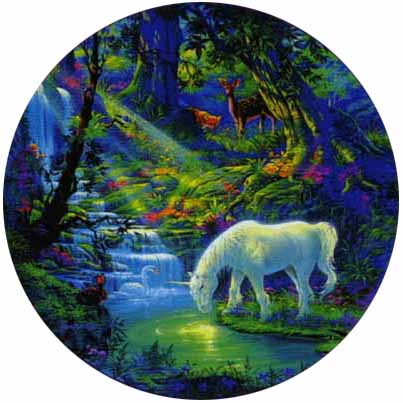
According to the book of Genesis, God gave Adam the task of naming everything he saw. In some translations of the Bible, the Unicorn was the first animal named; thereby, elevating it above all other beasts in the universe. When Adam and Eve left paradise, the Unicorn went with them and came to represent purity and chastity. Thus, the Unicorn's purity in the Western legends stems from its Biblical beginnings.
The Bible also offers an explanation about why the Unicorn has not been seen for so long. During the flood that engulfed the world for 40 days and 40 nights, Noah took two of each animal to safety, but Unicorns were not among them. A Jewish folk tale mentions they were originally on board but demanded so much space and attention that Noah banished them. They either drowned or managed to swim during the flood and still survive somewhere in the world or, as some believe, evolved into the narwhale.
There are seven clear references to the Unicorn in the Old Testament; although, there is now doubt about the original translations that may have erroneously named another animal as a Unicorn.
The Jewish Talmud also makes many similar references to the Unicorn. In Jewish folklore it is the fiercest of all animals and is able to kill an elephant with a single thrust from its horn.
Throughout history, the church has interpreted the Unicom in a number of different ways. In medieval times, it became a symbol of Christ himself, and its horn was symbolic of the unity of Christ and God.
Some medieval paintings show the Trinity with Christ represented by a Unicom. On the other hand, the Unicom also appears as a symbol of evil in the book of Isaiah. Overall, however, the Unicom has come to be regarded as a pure and virtuous animal. Regardless of the place of the Unicom in Biblical theory, it is evident that there was a strong belief in the animal's existence in Biblical times, as well as in the following centuries. It appears so often in the Old Testament that it can hardly be overlooked in the Christian world. The fact that it appears in the Bible meant that no devout Christian could doubt its authenticity.
The unicorn does not appear in early Greek mythology, but instead in Greek natural history, for Greek writers on natural history were convinced of the reality of the unicorn, which they located in India, a distant and fabulous realm for them. The Encycloaedia Britannica (1911) collects classical references to unicorns: the earliest description is from Ctesias, who described in Indica white wild asses, fleet of foot, having on the forehead a horn a cubit and a half in length, colored white, red and black; from the horn were made drinking cups which were a preventive of poisoning.
Aristotle must be following Ctesias when he mentions two one-horned animals, the oryx, a kind of antelope, and the so-called "Indian ass".
Pliny adds that "it cannot be taken alive" and quoting Ctesias, adds that India produces also a one-horned horse. The monoceros was sometimes called carcazonon, which may be a form of the Arabic carcadn, meaning "rhinoceros". Strabo says that in India there were one-horned horses with stag-like heads.
Medieval knowledge of the fabulous beast stemmed from biblical and ancient sources, the creature variously represented as a kind of wild ass, goat, or horse.
By A.D. 200, Tertullian had called the unicorn a small fierce kid-like animal, and a symbol of Christ. The predecessor of the medieval bestiary, compiled in Late Antiquity and known as Physiologus, popularized an elaborate allegory in which a unicorn, trapped by a maiden (representing the Virgin Mary) stood for the incarnation. As soon as the unicorn sees her it lays its head on her lap and falls asleep.
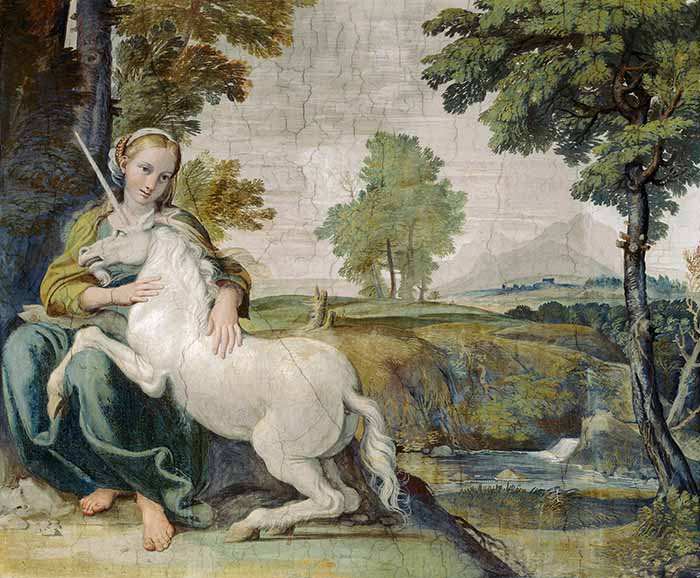
This became a basic emblematic tag that underlies medieval notions of the unicorn, justifying its appearance in every form of religious art.
The unicorn also figured in courtly terms: for some thirteenth-century French authors such as Thibaut of Champagne and Richard of Fournival, the lover is attracted to his lady as the unicorn is to the virgin. This courtly version of salvation provided an alternative to God's love and was assailed as heretical.
With the rise of humanism, the unicorn also acquired more orthodox secular meanings, emblemmatic of chaste love and faithful marriage. It plays this role in Petrarch's Triumph of Chastity.
The royal throne of Denmark was made of "unicorn horns". The same material was used for ceremonial cups because the unicorn's horn continued to be believed to neutralize poison, following classical authors.
The unicorn, tamable only by a virgin woman, was well established in medieval lore by the time Marco Polo described them as "scarcely smaller than elephants. They have the hair of a buffalo and feet like an elephant's. They have a single large black horn in the middle of the forehead. They have a head like a wild boar's. They spend their time by preference wallowing in mud and slime. They are very ugly brutes to look at. They are not at all such as we describe them when we relate that they let themselves be captured by virgins, but clean contrary to our notions." It is clear that Marco Polo was describing a rhinoceros.
In German, since the sixteenth century, Einhorn ("one-horn") has become a descriptor of the various species of rhinoceros.
In popular belief, examined wittily and at length in the seventeenth century by Sir Thomas Browne in his Pseudodoxia Epidemica, unicorn horns could neutralize poisons (book III, ch. xxiii). Therefore, people who feared poisoning sometimes drank from goblets made of "unicorn horn".
Alleged aphrodisiac qualities and other purported medicinal virtues also drove up the cost of "unicorn" products such as milk, hide, and offal. Unicorns were also said to be able to determine whether or not a woman was a virgin; in some tales, they could only be mounted by virgins.
One traditional method of hunting unicorns involved entrapment by a virgin.
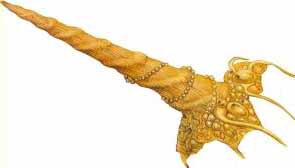
Because of the unicom's purity, its horn, sometimes called an 'Alicorn', was considered magical and became a popular ingredient in medieval medicines. Its mere presence was considered a strong protection against poison in food, and when worn in jewelry, it protected the wearer from evil.
Alicorn was often worth more than its weight in gold, so kings, emperors, and popes were among the few people able to pay the high prices demanded. They were eager to acquire the precious horn to "guarantee" long and healthy lives. With such a lucrative trade, false alicorn was rampant, made from bull horn, goat horn, or in some cases from the horns of exotic animals or from ordinary dog bones.
Complete Unicom horns were very rare. For example, a complete Unicom horn owned by Queen Elizabeth I of England was valued at the time at L10,000 - the equivalent of about 3,000 ounces of gold and enough money to buy a large country estate complete with a castle. Rather than coming from unicorns, these complete horns often turned out to be the long spirally twisted tusks of the male narwhal, a large marine animal. Kings often placed alicorn on the table to protect themselves against poisonous food and drink, and until the revolution toppled the monarchy in 1789, the eating utensils used by French kings were made of Unicom horn to counteract any poison in the food.
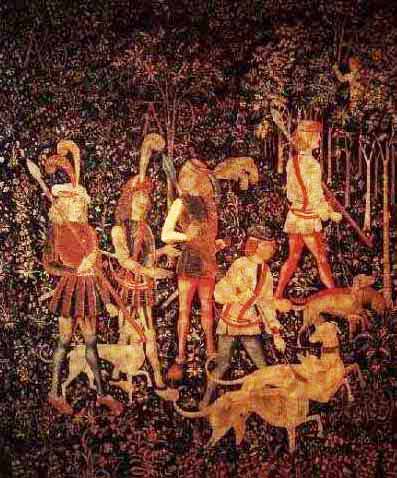
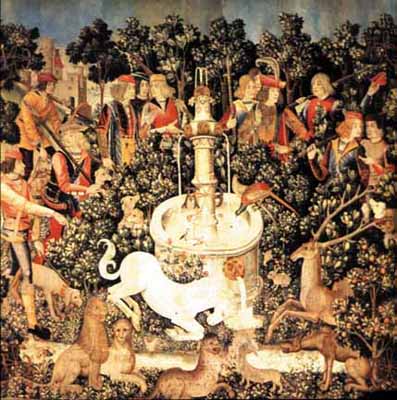
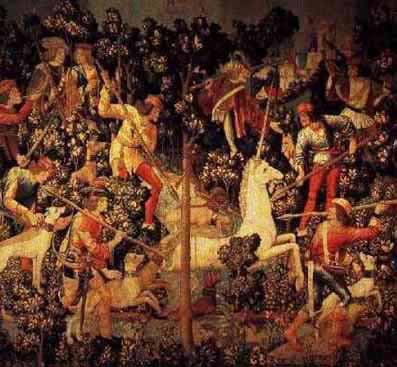
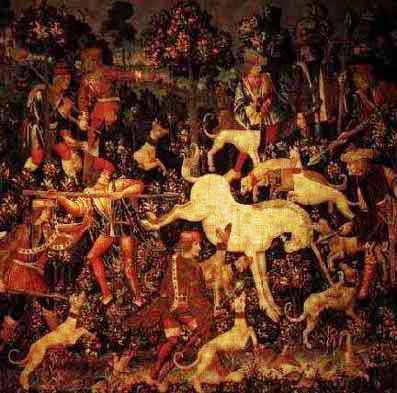
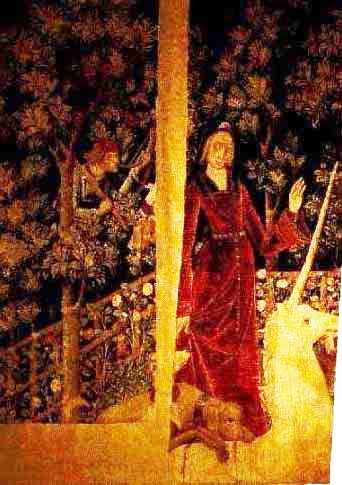
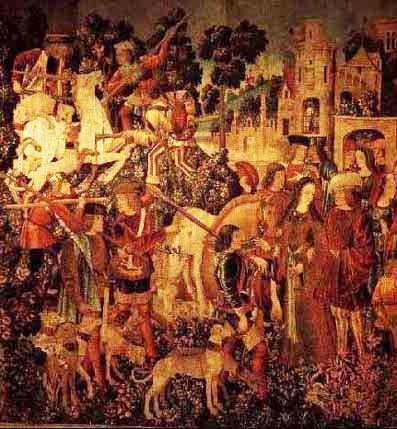
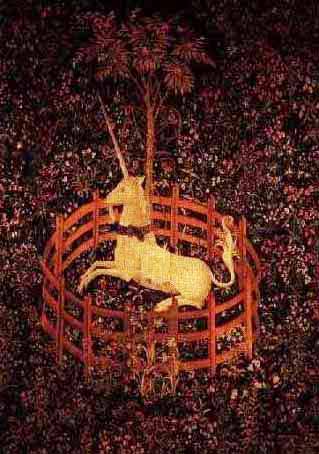
The famous late Gothic series of seven tapestry hangings, "The Hunt of the Unicorn" is a high point in European tapestry manufacture, combining both secular and religious themes. In the series, richly dressed noblemen, accompanied by huntsmen and hounds, pursue a unicorn against millefleurs backgrounds or settings of buildings and gardens. They bring the animal to bay with the help of a maiden who traps it with her charms, appear to kill it, and bring it back to a castle; in the last and most famous panel, "The Unicorn in Captivity,' the unicorn is shown alive again and happy, chained to a pomegranate tree surrounded by a fence, in a field of flowers.
Scholars conjecture that the red stains on its flanks are not blood but rather the juice from pomegranates, which were a symbol of fertility. However, the true meaning of the mysterious resurrected Unicorn in the last panel is unclear. The series was woven about 1500 in the Low Countries, probably Brussels or Liege, for an unknown patron. A set of six called the Dame a la licorne (Lady with the unicorn) at the Musee de Cluny, Paris, woven in the Southern Netherlands about the same time, pictures the five senses, the gateways to temptation, and finally Love ("A mon seul desir" the legend reads), with unicorns in each hanging.
The tapestries were bought by John D. Rockefeller in 1922 and are now on display at the Cloisters museum in New York.
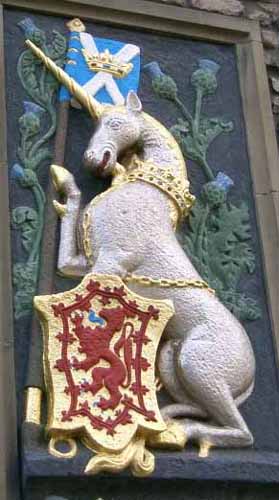
Arms of Scotland
In heraldry, a unicorn is depicted as a horse with a goat's cloven hooves and beard, a lion's tail, and a slender, spiral horn on its forehead. Whether because it was an emblem of the Incarnation or of the fearsome animal passions of raw nature, the unicorn was not widely used in early heraldry, but became popular from the fifteenth century. Though sometimes shown collared, which may perhaps be taken in some cases as an indication that it has been tamed or tempered, it is more usually shown collared with a broken chain attached, showing that it has broken free from its bondage and cannot be taken again.
It is probably best known from the royal arms of Scotland and the United Kingdom: two unicorns support the Scottish arms; a lion and a unicorn support the UK arms. The arms of the Society of Apothecaries in London has two golden unicorn supporters.
Since the rhinoceros is the only land animal to possess a single horn, it has often been supposed that the unicorn legend originated from encounters between Europeans and rhinoceroses. The Woolly Rhinoceros would have been quite familiar to Ice-Age people, or the legend may have been based on the surviving rhinoceroses of Africa. Europeans and West Asians have visited Sub-Saharan Africa for as long as we have records.
The Roman Empire also imported rhinoceroses for their arena 'games', along with hippopotamuses and other exotic creatures. Roman crowds could distinguish between the African and Indian rhinoceroses, both of which were slaughtered in front of huge crowds.
Chinese from the time of the Han Dynasty had also visited East Africa, which may account for their odd legends of 'one-horned ogres'. The Ming-dynasty voyages of Zheng He brought back giraffes, which were identified by the Chinese with another creature from their own legends.
One suggestion is that the unicorn myth is based on an extinct animal sometimes called the "Giant Unicorn" but known to scientists as Elasmotherium, a huge Eurasian rhinoceros native to the steppes, south of the range of the woolly rhinoceros of Ice Age Europe. Elasmotherium looked little like a horse, but it had a large single horn in its forehead. It seems to have become extinct about the same time as the rest of the glacial age megafauna.
However, according to the Nordisk familjebok and to space scientist Willy Ley, the animal may have survived long enough to be remembered in the legends of the Evenk people of Russia as a huge black bull with a single horn in the forehead.
Even if Elasmotherium is not the creature described by Ibn Fadlan, ordinary rhinoceroses may have some relation to the unicorn. In support of this claim, it has been noted that the 13th century traveller Marco Polo claimed to have seen a unicorn in Java, but his description (quoted above) makes it clear to the modern reader that he actually saw a Javanese rhinoceros.
The connection that is sometimes made with a single-horned goat derives from the vision of Daniel recorded in Book of Daniel 8:5:
In the domestic goat, a rare deformity of the generative tissues can cause the horns to be joined together; such an animal could be another possible inspiration for the legend. A farmer and a circus owner also produced fake unicorns, remodeling the "horn buttons" of goat kids, in such a way their horns grew deformed and joined in a grotesque seemingly single horn.
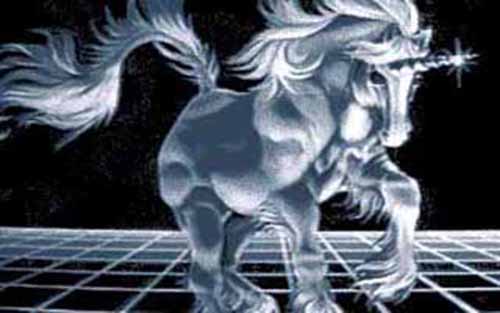
The unicorn's true origins lie in the depths of Time, in that beginning-less Beginning when all was emptiness and waste, darkness and mist. Then moved the Holy One to sunder the dark from the bright. So were established concord and balance, with darkness driven to the fringes and the Abode of Light at the middle point of all. But darkness once given a situation and compass for itself, grew weighty beyond accounting, intruding among all things and drawing them toward itself according to their weights and inclinations.
Therefore was the balance made to tremble, and from that trembling arose a resonance - an awesome sound that circled in the vast emptiness, chanting mightily. The Holy One modulated that sound to make of it a chord of great sweetness, and breathed into its intelligence, so that it might become a spirit of harmony and guidance unto every corner of the void. This was the powerful spirit called Galgallim, whirling itself through uncounted ages while ever spiraling around the central Light. And while some things still fell into darkness, yet Galgallim guided others on a more rarified path toward the shores of Light. In such a way was balance achieved once more.
Then the Holy One wished for a panel on which to display His greater art; and between the shores of Light and the walls of darkness He hung in balance the Earth. Its naked mountains He raised in fire and scattered them with shining gems that still reflect those flames. Then the Holy One addressed to the spirit of guidance, which is Galgallim, saying, "Out of the hidden gulfs I made thee, free and by form unbounded. Wilt thou accept shape upon Earth, that thou mayst supply a service even greater?" And even as it was asked, so it was agreed.
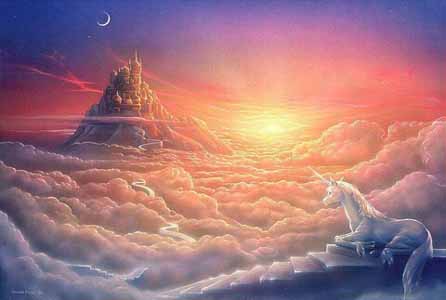
Wrapped in a cloud came he, by a bright whirlwind borne along. He descended gently from the heavens to the infant fields of Earth, even before the fires of its forming were yet subdued. Thus did the Unicorn possess the brightness of the Light, that he might drive all darkness and obscurity from him.
He was called Asallam, of unicorns the firstborn, a creature fearfully wrought and wonderful to behold, bearing a horn of spiral light that is the sign of Galgallim, the guide. Now with his horn Asallam struck a barren rock, piercing it to a great depth, and drew forth a gushing spring of life. Wherever those waters flowed, fires were quenched and the Earth was made fertile with a multitude of fruitful things. Great trees rose up and blossomed, and under their shade came beasts both wild and tame. All this was by the intent of the Holy One, and the Unicorn was the instrument of His will. In such a way was formed the Garden of the Unicorn, called Shamagim, which means the Place Where there is Water.
The Holy One then addressed the firstborn, saying, "Asallam! Of all my creations, thou alone shalt ever recall thy making, and dwell in remembrance unbroken of the Light, to be its guide and guardian. But never to the Light shalt thou return, until the final hour of the End of Time."
And the Unicorn dwelled in his garden and went walking abroad in great wonder. When the Holy One wished to make Himself known, even as all things were known to Him. Into Himself withdrawing, from earth and air, water and fire His sacred breath compounded Man, who was strong and fair, being the crown of all great ion. Looking upon Man, the Unicorn marveled, and became suddenly modest and shy. And because Asallam had no part in Man's making, the Unicorn loved Man the more and bowed before him as a servant. Thus was the Unicorn the first beast that Man beheld, and the first to which he gave a name. From that time to this, the fates of these two races have been bound together; for while the Unicorn leads toward the Light, only Man may pass therein. And this was the beginning of the First Age.
39,000 Years Ago, A Siberian Unicorn Lived Alongside Humans IFL Science - August 5, 2024
A beast that weighed in at around 3.5 tonnes once stomped across the grasslands of Eurasia, known as the Elasmotherium. It’s been coined the Siberian unicorn for the frankly outrageous horn atop its head, unsurprising as an ancient ancestor of the rhinoceros. What is surprising is that this near-mythical beast may have walked the Earth at the same time as humans. Once thought to have gone extinct around 200,000 to 100,000 years ago, recent dating of fossil evidence bumped its extinction to a mere 39,000 years ago.
Unicorns in southern Africa: The fascinating story behind one-horned creatures in rock art PhysOrg - June 24, 2023
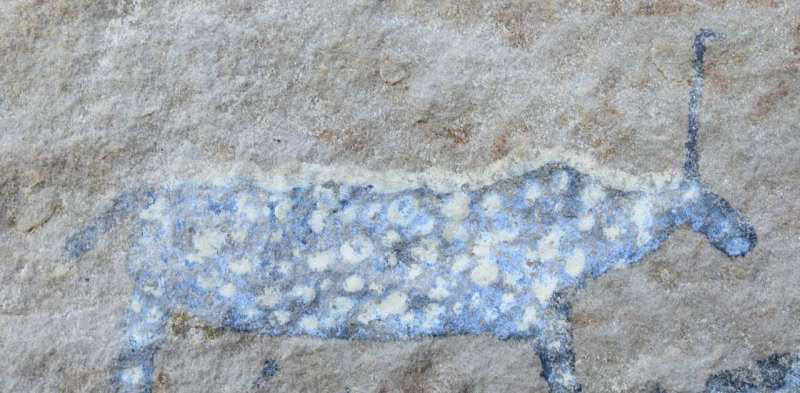
One-horned creatures are found in myths around the world. Although unicorns in different cultures have little to do with one another, they have multiple associations in European thought. For example, the Roman natural historian Pliny the Elder wrote about unicorns in the first century AD. The unicorn features in both medieval Christian and Celtic beliefs, and is Scotland's national animal. The unicorn's prominence in European culture spread across the globe with colonization.
In southern Africa, colonial European ideas encountered older indigenous beliefs about one-horned creatures. I've highlighted this in a recent research article about some of the region's rock art. In the age of natural science, unicorns were gradually dismissed as mythical rather than biological creatures. But some thought that real animals with single horns might yet exist in the "unexplored wilds" of Africa.